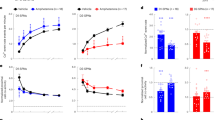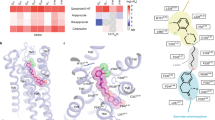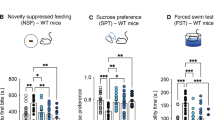Abstract
The relationship between clinically effective antipsychotic drug dosage and binding affinity to cloned dopamine (DA) and serotonin receptor subtypes was analyzed in an effort to elucidate the contribution of individual receptor subtypes to medication response. Clinically effective dose and binding affinity to D2 DA receptor were modestly correlated for typical antipsychotic medications (r=0.54, p=0.046), but surprisingly were not correlated for atypical antipsychotics (r=0.41, p=0.31). For typical antipsychotics, a more robust inverse relationship was observed between medication dose and 5-HT2C affinity (r=−0.68, p=0.021). The strongest correlation for typical antipsychotics was observed between drug dosage and 5-HT2C/D2 binding affinity ratio (r=−0.81, p=0.003). For atypical antipsychotics, no significant correlations were identified between medication dosage and 5-HT2C, 5-HT2A, 5-HT2C/D2, or 5-HT2A/D2 receptor-binding affinities. In contrast, atypical antipsychotic medication dosage was highly correlated with the ratios of D2 (5-HT2A/5-HT1A) (r=0.80, p=0.031), and D2 (5-HT2C/5-HT1A) (r=0.78, p=0.038) binding affinities. These observations demonstrate an interaction between D2 and 5-HT2C receptor effects contributing to positive symptom response for typical antipsychotic medications, suggesting that signaling through 5-HT2C receptors interacts with and improves antipsychotic effects achieved via D2 receptor blockade. This analysis also demonstrates that, in contrast to typical antipsychotics, therapeutic effects of atypical antipsychotic medications are determined by opposing interactions among three different domains: (1) increasing D2 DA receptor-binding affinity enhances antipsychotic potency. (2) Increasing 5-HT2C and 5-HT2A receptor-binding affinities also facilitate antipsychotic efficacy. (3) Increasing 5-HT1A receptor-binding affinity, in contrast, reduces antipsychotic efficacy.
Similar content being viewed by others
Log in or create a free account to read this content
Gain free access to this article, as well as selected content from this journal and more on nature.com
or
References
Alex KD, Yavanian GJ, McFarlane HG, Pluto CP, Pehek EA (2005). Modulation of dopamine release by striatal 5-HT2C receptors. Synapse 55: 242–251.
Baldessarini RJ, Cohen BM, Teicher MH (1993). Clinical dosing of neuroleptics. Psychopharmacol Ser 10: 138–148.
Bernstein JG (1988). Handbook of Drug Therapy in Psychiatry. PSG Publishing Company, Inc.: Littleton, MA.
Bollini P, Pampallona S, Orza MJ, Adams ME, Chalmers TC (1994). Antipsychotic drugs: is more worse? A meta-analysis of the published randomized control trials. Psychol Med 24: 307–316.
Bunzow JR, Van Tol HH, Grandy DK, Albert P, Salon J, Christie M et al (1988). Cloning and expression of a rat D2 dopamine receptor cDNA. Nature 336: 783–787.
Carlsson A, Waters N, Carlsson ML (1999). Neurotransmitter interactions in schizophrenia-therapeutic implications. Eur Arch Psychiatry Clin Neurosci 249 (Suppl 4): 37–43.
Creese I, Burt DR, Snyder SH (1976). Dopamine receptor binding predicts clinical and pharmacological potencies of antischizophrenic drugs. Science 192: 481–483.
De Deurwaerdere P, Navailles S, Berg KA, Clarke WP, Spampinato U (2004). Constitutive activity of the serotonin2C receptor inhibits in vivo dopamine release in the rat striatum and nucleus accumbens. J Neurosci 24: 3235–3241.
De Deurwaerdere P, Spampinato U (1999). Role of serotonin(2A) and serotonin(2B/2C) receptor subtypes in the control of accumbal and striatal dopamine release elicited in vivo by dorsal raphe nucleus electrical stimulation. J Neurochem 73: 1033–1042.
Di Giovanni G, De Deurwaerdere P, Di Mascio M, Di Matteo V, Esposito E, Spampinato U (1999). Selective blockade of serotonin-2C/2B receptors enhances mesolimbic and mesostriatal dopaminergic function: a combined in vivo electrophysiological and microdialysis study. Neuroscience 91: 587–597.
Di Matteo V, Cacchio M, Di Giulio C, Esposito E (2002). Role of serotonin(2C) receptors in the control of brain dopaminergic function. Pharmacol Biochem Behav 71: 727–734.
Di Matteo V, Di Giovanni G, Di Mascio M, Esposito E (1999). SB 242084, a selective serotonin2C receptor antagonist, increases dopaminergic transmission in the mesolimbic system. Neuropharmacology 38: 1195–1205.
Eberle-Wang K, Mikeladze Z, Uryu K, Chesselet MF (1997). Pattern of expression of the serotonin2C receptor messenger RNA in the basal ganglia of adult rats. J Comp Neurol 384: 233–247.
Emilien G, Maloteaux JM, Geurts M, Hoogenberg K, Cragg S (1999). Dopamine receptors—physiological understanding to therapeutic intervention potential. Pharmacol Ther 84: 133–156.
Fargin A, Raymond JR, Lohse MJ, Kobilka BK, Caron MG, Lefkowitz RJ (1988). The genomic clone G-21 which resembles a beta-adrenergic receptor sequence encodes the 5-HT1A receptor. Nature 335: 358–360.
Filip M, Cunningham KA (2003). Hyperlocomotive and discriminative stimulus effects of cocaine are under the control of serotonin(2C) (5-HT(2C)) receptors in rat prefrontal cortex. J Pharmacol Exp Ther 306: 734–743.
Geddes J, Freemantle N, Harrison P, Bebbington P (2000). Atypical antipsychotics in the treatment of schizophrenia: systematic overview and meta-regression analysis. BMJ 321: 1371–1376.
Grottick AJ, Fletcher PJ, Higgins GA (2000). Studies to investigate the role of 5-HT(2C) receptors on cocaine- and food-maintained behavior. J Pharmacol Exp Ther 295: 1183–1191.
Huttunen M (1995). The evolution of the serotonin-dopamine antagonist concept. J Clin Psychopharmacol 15: 4S–10S.
Julius D, MacDermott AB, Axel R, Jessell TM (1988). Molecular characterization of a functional cDNA encoding the serotonin 1c receptor. Science 241: 558–564.
Kaplan HI, Sadock BJ, Grebb JA (1994). Dopamine receptor antagonists (antipsychotics). In: Cancro R, Gabbard GO, Jones RM, Kaplan PM, Pataki CS, Sadock VA (eds). Synopsis of Psychiatry. Williams and Wilkins: Philadelphia. pp 940–960.
Kapur S, Remington G (2001). Dopamine D(2) receptors and their role in atypical antipsychotic action: still necessary and may even be sufficient. Biol Psychiatry 50: 873–883.
Kapur S, Seeman P (2001). Does fast dissociation from the dopamine d(2) receptor explain the action of atypical antipsychotics? A new hypothesis. Am J Psychiatry 158: 360–369.
Lee SP, O'Dowd BF, Ng GY, Varghese G, Akil H, Mansour A et al (2000). Inhibition of cell surface expression by mutant receptors demonstrates that D2 dopamine receptors exist as oligomers in the cell. Mol Pharmacol 58: 120–128.
Leucht S, Pitschel-Walz G, Abraham D, Kissling W (1999). Efficacy and extrapyramidal side-effects of the new antipsychotics olanzapine, quetiapine, risperidone, and sertindole compared to conventional antipsychotics and placebo. A meta-analysis of randomized controlled trials. Schizophr Res 35: 51–68.
Leysen JE, Janssen PM, Schotte A, Luyten WH, Megens AA (1993). Interaction of antipsychotic drugs with neurotransmitter receptor sites in vitro and in vivo in relation to pharmacological and clinical effects: role of 5HT2 receptors. Psychopharmacology (Berlin) 112: S40–S54.
Lopez-Gimenez JF, Mengod G, Palacios JM, Vilaro MT (2001). Regional distribution and cellular localization of 5-HT2C receptor mRNA in monkey brain: comparison with mesulergine binding sites and choline acetyltransferase mRNA. Synapse 42: 12–26.
Marquis KL, Sabb AL, Logue SF, Brennan JA, Piesla MJ, Comery TA et al (2007). WAY-163909 ((7bR,10aR)-1,2,3,4,8,9,10,10a-octahydro-7bH-cyclopenta-[b]diazepino[6,7,1hi]indole): a novel 5-HT2C receptor selective agonist with preclinical antipsychotic-like activity. J Pharmacol Exp Ther 320: 486–496.
Meltzer HY (1989). Clinical studies on the mechanism of action of clozapine: the dopamine-serotonin hypothesis of schizophrenia. Psychopharmacology (Berlin) 99 (Suppl): S18–S27.
Meltzer HY (1995). The role of serotonin in schizophrenia and the place of serotonin-dopamine antagonist antipsychotics. J Clin Psychopharmacol 15: 2S–3S.
Meltzer HY (1999). The role of serotonin in antipsychotic drug action. Neuropsychopharmacology 21: 106S–115S.
Meltzer HY, Li Z, Kaneda Y, Ichikawa J (2003). Serotonin receptors: their key role in drugs to treat schizophrenia. Prog Neuropsychopharmacol Biol Psychiatry 27: 1159–1172.
Meltzer HY, Matsubara S, Lee JC (1989a). Classification of typical and atypical antipsychotic drugs on the basis of dopamine D-1, D-2 and serotonin2 pKi values. J Pharmacol Exp Ther 251: 238–246.
Meltzer HY, Matsubara S, Lee JC (1989b). The ratios of serotonin2 and dopamine2 affinities differentiate atypical and typical antipsychotic drugs. Psychopharmacol Bull 25: 390–392.
Millan MJ (2000). Improving the treatment of schizophrenia: focus on serotonin (5-HT)(1A) receptors. J Pharmacol Exp Ther 295: 853–861.
Millan MJ, Dekeyne A, Gobert A (1998). Serotonin (5-HT)2C receptors tonically inhibit dopamine (DA) and noradrenaline (NA), but not 5-HT, release in the frontal cortex in vivo. Neuropharmacology 37: 953–955.
Navailles S, De Deurwaerdere P, Spampinato U (2006). Clozapine and haloperidol differentially alter the constitutive activity of central serotonin2C receptors in vivo. Biol Psychiatry 59: 568–575.
Nimchinsky EA, Hof PR, Janssen WGM, Morrison JH, Schmauss C (1997). Expression of dopamine D3 receptor dimers and tetramers in brain and in transfected cells. J Biol Chem 272: 29229–29237.
Niswender CM, Copeland SC, Herrick-Davis K, Emeson RB, Sanders-Bush E (1999). RNA editing of the human serotonin 5-hydroxytryptamine 2C receptor silences constitutive activity. J Biol Chem 274: 9472–9478.
Pozzi L, Acconcia S, Ceglia I, Invernizzi RW, Samanin R (2002). Stimulation of 5-hydroxytryptamine (5-HT(2C)) receptors in the ventrotegmental area inhibits stress-induced but not basal dopamine release in the rat prefrontal cortex. J Neurochem 82: 93–100.
Pritchett DB, Bach AW, Wozny M, Taleb O, Dal Toso R, Shih JC et al (1988). Structure and functional expression of cloned rat serotonin 5HT-2 receptor. EMBO J 7: 4135–4140.
Protais P, Chagraoui A, Arbaoui J, Mocaer E (1994). Dopamine receptor antagonist properties of S 14506, 8-OH-DPAT, raclopride and clozapine in rodents. Eur J Pharmacol 271: 167–177.
Rauser L, Savage JE, Meltzer HY, Roth BL (2001). Inverse agonist actions of typical and atypical antipsychotic drugs at the human 5-hydroxytryptamine(2C) receptor. J Pharmacol Exp Ther 299: 83–89.
Roth BL, Lopez E, Beischel S, Westkaemper RB, Evans JM (2004). Screening the receptorome to discover the molecular targets for plant-derived psychoactive compounds: a novel approach for CNS drug discovery. Pharmacol Ther 102: 99–110.
Scarselli M, Novi F, Schallmach E, Lin R, Baragli A, Colzi A et al (2001). D2/D3 dopamine receptor heterodimers exhibit unique functional properties. J Biol Chem 276: 30308–30314.
Schoemaker H, Claustre Y, Fage D, Rouquier L, Chergui K, Curet O et al (1997). Neurochemical characteristics of amisulpride, an atypical dopamine D2/D3 receptor antagonist with both presynaptic and limbic selectivity. J Pharmacol Exp Ther 280: 83–97.
Seeman P (2002). Atypical antipsychotics: mechanism of action. Can J Psychiatry 47: 27–38.
Seeman P, Corbett R, Van Tol HH (1997). Atypical neuroleptics have low affinity for dopamine D2 receptors or are selective for D4 receptors. Neuropsychopharmacology 16: 93–110.
Seeman P, Lee T, Chau-Wong M, Wong K (1976). Antipsychotic drug doses and neuroleptic/dopamine receptors. Nature 261: 717–719.
Seeman P, Tallerico T (1998). Antipsychotic drugs which elicit little or no parkinsonism bind more loosely than dopamine to brain D2 receptors, yet occupy high levels of these receptors. Mol Psychiatry 3: 123–134.
Sokoloff P, Giros B, Martres MP, Bouthenet ML, Schwartz JC (1990). Molecular cloning and characterization of a novel dopamine receptor (D3) as a target for neuroleptics. Nature 347: 146–151.
Strange PG (2001). Antipsychotic drugs: importance of dopamine receptors for mechanisms of therapeutic actions and side effects. Pharmacol Rev 53: 119–133.
Van Tol HH, Bunzow JR, Guan HC, Sunahara RK, Seeman P, Niznik HB et al (1991). Cloning of the gene for a human dopamine D4 receptor with high affinity for the antipsychotic clozapine. Nature 350: 610–614.
Vuckovic A, Cohen BM, Keck PEJ, Shedlack KJ (1990). Neuroleptic dosage regimens in psychotic inpatients: a retrospective comparison. J Clin Psychiatry 51: 107–109.
Vysokanov A, Flores-Hernandez J, Surmeier DJ (1998). mRNAs for clozapine-sensitive receptors co-localize in rat prefrontal cortex neurons. Neurosci Lett 258: 179–182.
Westphal RS, Backstrom JR, Sanders-Bush E (1995). Increased basal phosphorylation of the constitutively active serotonin 2C receptor accompanies agonist-mediated desensitization. Mol Pharmacol 48: 200–205.
Wood MD, Scott C, Clarke K, Cato KJ, Patel N, Heath J et al (2006). Pharmacological profile of antipsychotics at monoamine receptors: atypicality beyond 5-HT2A receptor blockade. CNS Neurol Disord Drug Targets 5: 445–452.
Zawarynski P, Tallerico T, Seeman P, Lee SP, O'Dowd BF, George SR (1998). Dopamine D2 receptor dimers in human and rat brain. FEBS Lett 441: 383–386.
Zimbroff DL, Kane JM, Tamminga CA, Daniel DG, Mack RJ, Wozniak PJ et al (1997). Controlled, dose-response study of sertindole and haloperidol in the treatment of schizophrenia. Sertindole Study Group. Am J Psychiatry 154: 782–791.
Acknowledgements
This work was supported by the Department of Veterans Affairs Medical Research Service, and by a NARSAD Essel Investigator Award (NMR).
Author information
Authors and Affiliations
Corresponding author
Additional information
Statement of Interests
The authors disclose the following relationships, which might potentially bias this work:
Neil M Richtand: Grant support: Janssen, AstraZeneca
Speaker's bureaus: Bristol-Myers Squibb, Pfizer, and Otsuka America Pharmaceutical.
Consultant: Solvay Pharmaceuticals
Stephen M Strakowski: Grant support: Eli Lilly, Janssen, Pfizer, Forrest, AstraZeneca, Bristol-Myers Squibb
Consultant: OrthoMcNeil, Pfizer
Speaker's bureaus: Eli Lilly, Janssen, Pfizer, Forrest, AstraZeneca, Bristol-Myers Squibb, OrthoMcNeil
Paul E Keck Jr: Grant support: principal or co-investigator on research studies sponsored by: Abbott Laboratories, the American Diabetes Association, AstraZeneca, Bristol-Myers Squibb, GlaxoSmithKline, Eli Lilly, Janssen Pharmaceutica, Memory Pharmaceuticals, Merck, National Institute of Mental Health (NIMH), National Institute of Drug Abuse (NIDA), Organon, Ortho-McNeil, Pfizer, the Stanley Medical Research Institute (SMRI), and UCB Pharma.
Dr Keck is a consultant to, or member of the scientific advisory boards of: Abbott Laboratories, AstraZeneca Pharmaceuticals, Bristol-Myers Squibb, GlaxoSmithKline, Janssen Pharmceutica, Eli Lilly and Company, Memory Pharmaceuticals, Neurocrine Biosciences, Ortho-McNeil, Pfizer, and Shire.
Rights and permissions
About this article
Cite this article
Richtand, N., Welge, J., Logue, A. et al. Dopamine and Serotonin Receptor Binding and Antipsychotic Efficacy. Neuropsychopharmacol 32, 1715–1726 (2007). https://doi.org/10.1038/sj.npp.1301305
Received:
Revised:
Accepted:
Published:
Issue date:
DOI: https://doi.org/10.1038/sj.npp.1301305
Keywords
This article is cited by
-
DRD2 co-expression network and a related polygenic index predict imaging, behavioral and clinical phenotypes linked to schizophrenia
Translational Psychiatry (2017)
-
Dopamine D2/3 receptor antagonism reduces activity-based anorexia
Translational Psychiatry (2015)
-
Effect of thioridazine on antioxidant status of HEMn-DP melanocytes
Naunyn-Schmiedeberg's Archives of Pharmacology (2015)
-
Comparative Analysis of the Treatment of Chronic Antipsychotic Drugs on Epileptic Susceptibility in Genetically Epilepsy-prone Rats
Neurotherapeutics (2015)
-
Differential regulation of observational fear and neural oscillations by serotonin and dopamine in the mouse anterior cingulate cortex
Psychopharmacology (2014)



